Never too early to plan for next school year!
I just love a good continuum – and it’s a visual supp
Welcome, and I hope this month is starting off well for you! Last time, we paired an animation and activity focused on that popular feeling, frustration. Let’s keep going with that theme and add the idea of continuums – after all, like the majority of feelings and social learning concepts, frustration fits well on the visual image of a continuum.
Take for example, the animation Scrambled, by Polder Animation. The woman demonstrates lots of frustration, but it moves along a continuum as the story unfolds. Her feeling isn’t just in one spot – sometimes less frustrated, sometimes more.
For this activity, draw out a continuum and work with your students adding verbal descriptions along three or five points (e. g. “not frustrated at all”, “SUPER frustrated”, etc.) It doesn’t need to be fancy, and it’s great to add the language the students come up with, like in the example above.
Now, watch and pause the video as you pose the question “How frustrated is she now?” “How about now?” “And now?”
The message here is that our feelings, in this case frustration, are usually in flux. Now, turn the discussion to the students – do they agree that their feelings of frustration are often also moving along a continuum?
You can then transition into applied practice. Introduce an activity that is bound to elicit some frustration – last time I talked about Gravitrax, but I also love using a tabletop game like Trapdoor Checkers or Taco vs. Burrito. As the students play, have them use the same continuum that they studied during the video work. How do they feel their levels of frustration move? Do we need different strategies for different points on the continuum? When frustration is more intense, is it because additional feelings, like sadness and worry are adding on? Lots to discuss here!
My Feeling Fixers can make Taco vs. Burrito a bit less frustrating!
Until I see you in July, take good care!


